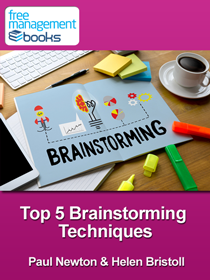Top 5 Brainstorming Techniques - Free eBook in PDF Format
 |
 |
|
Book Description - ISBN 966-1-52521-928-3 (38 Pages)
This free eBook describes five of the most popular brainstorming techniques used in group situations to encourage creative thinking. Brainstorming has moved beyond just being used by marketing professionals and is now popular in all areas of management. Make sure that you know how and when to use each of these techniques to aid your decision-making.
Chapter 1 - Brainstorming
One of the most common techniques used to creative new ideas is brainstorming, whether in groups or as an individual. To be effective management must encourage creativity by removing any barriers that existing beliefs, procedures or operations put on creative thinking. The purpose of brainstorming is to generate as many ideas as possible and then carefully select the one or two that will enhance your organization.
Chapter 2 - 6-3-5 Brainwriting
When faced with a specific problem managers will find the 6-3-5 brainwriting is an excellent way to think in a creative way to fins the best solution. Each number forms a different part of the creative process. Six people make up the creative team assigned the task of developing the ideas. A moderator aids them. Three is the number of ideas each member presents to the rest of the creative team. Five represents the number of minutes allocated to each stage of the process. (This time can be extended for more complex problems.)
Chapter 3 - Reverse Brainstorming
This method of brainstorming literally reverses the problem you face. This means that the group discusses how to resolve the opposite of the original problem. Reverse brainstorming requires that the original problem is very clearly defined and by forcing individuals to look at the problem from a completely different angle hidden issues will come to light. The improved understanding of the original problem then enables a resolution to be found.
Chapter 4 - Round-Robin Brainstorming
This technique of brainstorming provides a more structured format to a creative session. The problem to resolve is clearly and concisely defined and the people are asked to write an idea on the piece of paper in front of them and pass it to the person on their right. This process is repeated for the defined number of rounds. Individuals can use the idea(s) on each sheet to inspire them if they wish. Round-robin brainstorming ensures every voice is heard and is especially useful in groups that consist of a wide variety of personalities and cultural behaviors.
Chapter 5 - Rolestorming
This creative tool combines the methods of role playing and brainstorming. This technique assigns a role or persona to each member of the team, which dictates how they will think and act during the brainstorming session. The roles to be used in each session will vary according to the problem to be addressed. The essential part of this technique is that no one plays themselves, enabling them to appreciate the problem from a totally different perspective.
| You will learn: |
|
![]()
![]()
What is Brainstorming?
- Brainstorming is one of the fundamental building blocks of creativity and most people will have used it in some form when trying to come up with new ideas.
- Even if you have used it before, it is such a powerful tool that it is worth taking the time to see if you could improve the way you approach it in the future.
- The most important thing is to create a brainstorming environment that is supportive and encouraging because you want to allow all participants to use their creativity as fully as possible.
- Brainstorming is meant to be a form of creativity that places an emphasis on freedom, but you still need to have some basic structure in place for your brainstorming sessions.
- The key is to have asked the right question or to have posed the problem in a way that at least some of the results of the brainstorming session are usable.
What is 6-3-5 Brainwriting?
- While brainstorming is an excellent creativity tool, it does have its limitations due to the lack of rules and structure.
- Traditional group brainstorming sessions can easily become dominated by one or two people, with everyone else winding up in the background.
- To get around this problem, you can implement the process of 6-3-5 brainwriting.
- There are going to be six people tasked with developing ideas to solve a given problem, in addition to one person who is going to serve as the moderator.
- During each round of the brainwriting session, each person involved is going to be asked to come up with three ideas that are written down on a worksheet.
- Five minutes are going to be allotted for each stage of this process, during which each of the six people will need to come up with three ideas.
- This approach tends to save time and prevent the exercise from becoming dominated by the participants with the loudest voices.
- It also encourages contributors to build on the ideas of others because it takes place in several rounds.
What is Reverse Brainstorming?
- Brainstorming is one of the most open and free-flowing forms of creativity that asks individuals and groups to simply come up with as many ideas as possible.
- Regular brainstorming will often take you in many different directions at the same time, which often leads to wasted time as it is easy to drift away from the original problem.
- Reverse brainstorming begins by clearly defining the problem and writing it down on a sheet of paper.
- The ‘reverse’ aspect comes from the next step which is to phrase the problem or issue the opposite way around.
- You then brainstorm the reversed problem in order to come up with as many ideas as possible, even though they will have the an entirely detrimental effect on the original problem.
- The final stage is to reverse these ideas and apply them to the original problem.
- This may seem convoluted but turning your usual way of thinking on its head can often result in genuinely new ideas being considered.
What is Round-Robin Brainstorming?
- There are some downsides to brainstorming in a group setting, specifically when it comes to the issue of one or two people dominating the conversation.
- Round-robin brainstorming can help address this by making sure that everyone gets a voice.
- The technique involves each participant writing down their ideas on a piece of paper which is then passed on to another participant after a predetermined time.
- This carries on for a predetermined number of rounds with each participant adding their own ideas which may or may not be based on what has already been written.
- If anonymity is important then it is possible to use a software tool.
- With a growing list of other people’s ideas to reference the session moves on, round-robin brainstorming has the potential to greatly outperform a standard brainstorming meeting.
What is Rolestorming?
- Although brainstorming is extremely popular there are some commonly accepted drawbacks which limit its usefulness in the group setting.
- Firstly, it does not suit those who don’t have much self-confidence.
- Secondly, once one good idea has been produced by the ground, there is a tendency to just settle for that solution and move on.
- Thirdly, ideas which may be seen as outside-the-box may be deemed to risky to propose.
- Rolestorming involves your team members assuming other personas while brainstorming.
- This can help participants to look at a given topic from another perspective and allows them to voice points of view which they would be uncomfortable with in their normal role.


